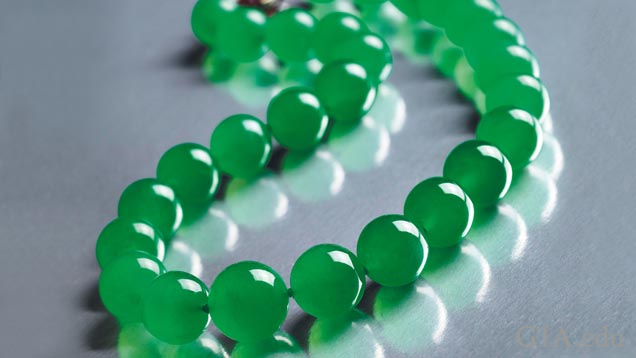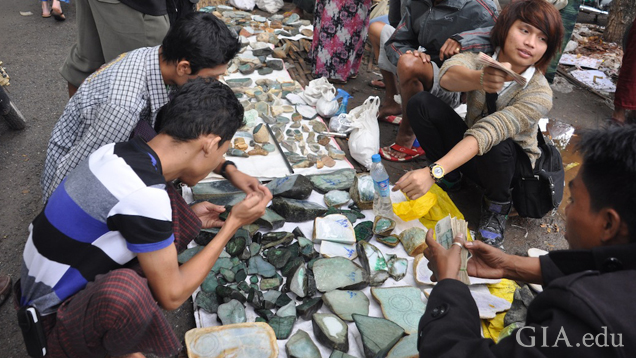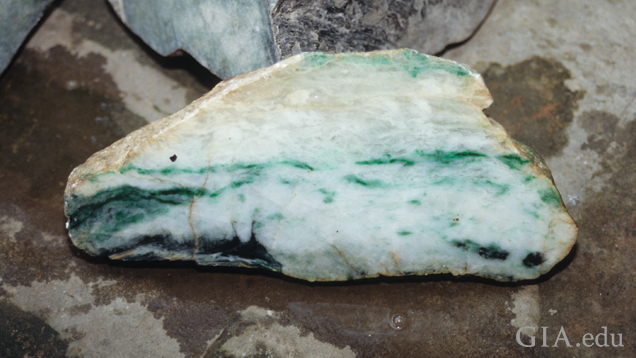Jade Report: Increased Mining Creates Large Stockpiles
April 11, 2017

The Chinese retail market has been cooling off, but jade mining in the Kachin province of Myanmar has been on the increase, causing a massive inventory buildup, according to a report by the Ash Center for Democratic Governance and Innovation of Harvard University.
The report is based on information from government sources and traders in Hpakant, Kachin province, the 30-square-mile source for nearly all jadeite. The authors noted that production began to expand in 2015 and jade dealers in Hong Kong corroborated the report’s observation of large and growing stockpiles of the gem in warehouses near the Myanmar border and dealers’ safes. It does not estimate the size of jade stocks, but interviews with others involved in or monitoring the jade trade agree it is extremely large.
“If China wanted to whittle down their stockpiles, they probably could do without (newly produced) jade for five to 10 years,” said one Myanmar-based official with close connections to dealers and the government.
Jade stocks are accumulating because production has far exceeded the market’s ability to absorb it. Some goods are locked in customs over ongoing valuation disputes and, more recently, there is a reluctance to sell better quality materials because prices have been softening. Producers and dealers can sit on large stocks because capital costs of mining are low and they do not rely on bank financing and don’t accumulate additional costs by holding inventory.
The report shows that jade production for the first nine months of 2015 (the latest available figures) totaled 24,000 metric tons, or 2.5 times the same period in 2014.
Myanmar’s central government cannot control illegal mining, according to the report, because it is involved with the rebel Kachin Independence Army, which has ratcheted up campaigns against it. The government has tried to limit access to the Hpakant region, by restricting new mining licenses and attempting to suspend mining after a series of deadly rock falls.
But mining for jade continues and as many as 200,000 unlicensed diggers continue to work the extensive waste piles, which has created enormous social problems and unsafe conditions. Nine diggers were killed on Feb. 10 when a slag pile collapsed onto them, according to a report in Radio Free Asia.

Retail Demand for Jade is Decreasing
The Ash Center estimated jade production at Hpakant to be worth $7.9 billion in 2011, possibly increasing to $15 billion in 2015 because of the rise in mining activity. A 2015 Global Witness report estimated the jade trade at $31 billion, a figure most analysts agree is excessive. To put that number in perspective, worldwide rough diamond production in 2015 was valued at just under $14 billion, with the worldwide polished wholesale market valued at $22 billion.
Chinese jewelry retailers report that jade sales slowed by 20% or more in 2016. Jade dealers at the September 2016 Hong Kong Watch and Jewellery Show noted that prices for the gem, even top quality “A” material, had fallen substantially − 20% to 40% in the past two years − as the Chinese government began to crack down on large cash purchases as a way to curtail corruption. In addition, the Chinese government also enacted an excise tax on jade imports to discourage demand.
China’s top retailers do not break down sales by gemstone categories, but the country’s largest chain, Hong Kong-based Chow Tai Fook’s 2,057 stores logged sales of $7.2 billion in 2016, down from a 2014 peak of $9.9 billion. Gem-set pieces (including jade) account for 27% of the company’s sales.
Sales at Chow Sang Sang, another prominent Chinese jewelry retail chain, fell 16% in fiscal 2016, to just over $1 billion and Luk Fook Holding’s, also a large jewelry chain, saw its sales decline 21% in fiscal 2016 to $700 million.
The majority of jade is worked on in China with an estimated 500,000 people employed in various stages of processing, according to dealers. It is mostly sold through specialized retailers or traditional marketplaces that don’t disclose their sales activity. An increasing amount of medium quality “B” and lower quality “C” jade, however, is being sold via Chinese internet sites such as Weibo and WeChat. These internet sales are hurting traditional jade retailers, according to reports in China.

The Future of Myanmar Jade Mining
Regaining sufficient control over Myanmar’s jade production to regulate production, enforce environmental and safety standards, and restore government revenues would be a very difficult task, according to the Ash Center report.
The conflict in Kachin, a large province in the north central portion of the country, has been raging for years. Some officials of the Kachin Independence Army earn money trafficking in illicitly mined jade, in addition to “tolls” collected from individuals and companies traveling through the area, according to the report. Any settlement must take these factors into account.
Complicating matters, mine concession owners, many of whom are Chinese, need to be willing to pay sufficient taxes to support government health and education programs, particularly because drug addiction remains rampant, especially among miners, who require these social services.
The Ash Center has proposed a revenue sharing structure that will enable mine owners to keep their concessions, while paying royalties of 50% on the full wholesale value of jade exported, plus business taxes. An elected government in Kachin, supported by both the military and separatists groups, would enforce environmental policies and provide health and education services to the populace. Non-Governmental Organizations could serve as monitors to ensure those standards are upheld.
The report also maintains that an equitable power-sharing arrangement would make it possible to develop hydroelectric power operations and the ability to responsibly mine other resources in the area, including amber and gold.
Russell Shor is senior industry analyst at GIA in Carlsbad.



